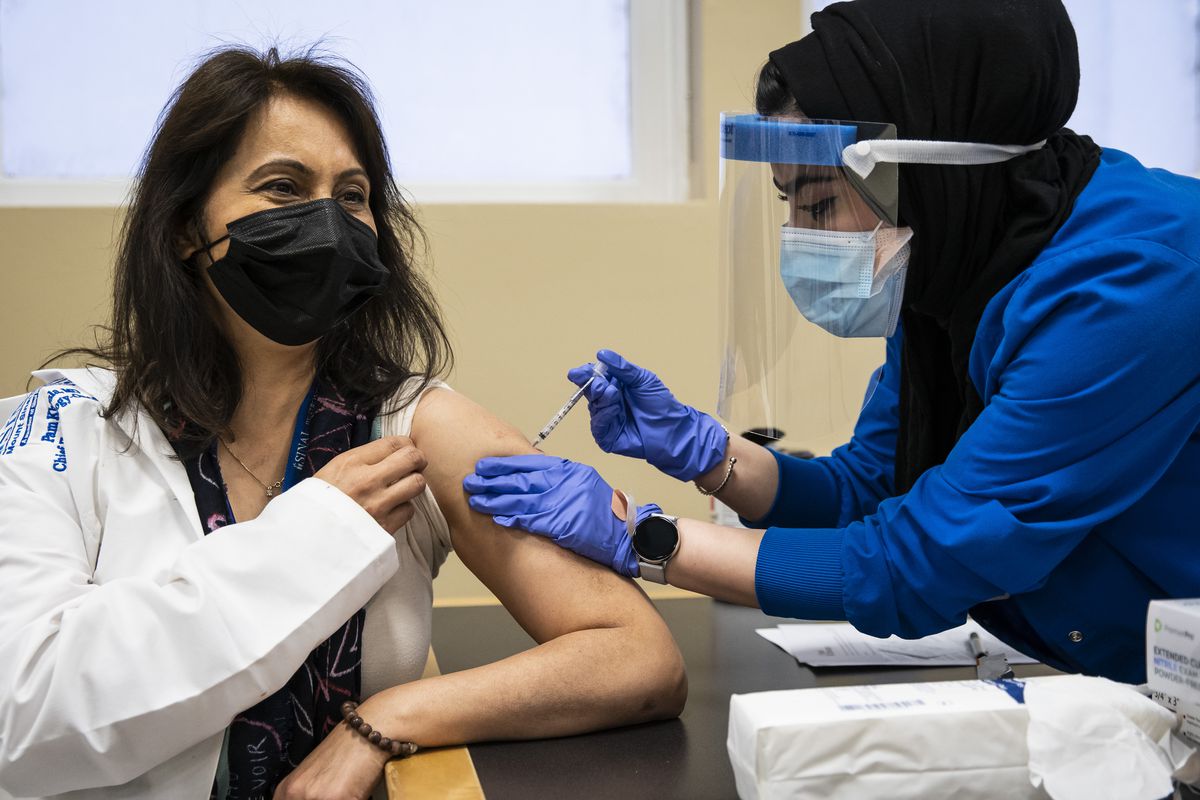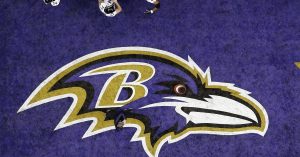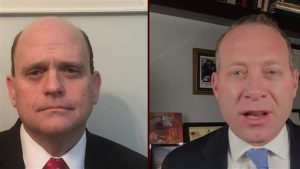The latest
Vaccine’s unbalanced rollout: Few South, West side residents get COVID shots so far
Doctors, nurses and other health care workers who live near downtown or on the North Side stepped forward in large numbers to get vaccinated for COVID-19, while a smaller number of the city’s South Side and West Side residents got the shots.
The findings, from city data for the first 12 days of vaccinations along with census information showing where health care workers live, point to a trend of Chicago doctors living in more affluent areas showing up in sizable numbers to get inoculated while technicians and other lower-paid health care workers living in predominantly Black and Latino communities did not get the shots.
The numbers signal the challenge ahead for Mayor Lori Lightfoot and Chicago public health officials who have said they expect resistance from minority residents who may distrust the vaccination process. Health care workers are the first in line to receive the shots, and city officials hope Black and Latino nurses, doctors and others will set the example for the broader population in communities of color.
“This is exactly the challenge,” Dr. Allison Arwady, the city’s public health chief, said in an interview. “Our whole plan here in Chicago is really about equity, and it’s about recognizing there is a lot of extra work that needs to go in to see a map that shows equitable vaccine uptake.”
Arwady said she was “not at all surprised this is how the very first week of data look” but added, “I am confident that it will improve as more vaccine is available both within hospitals, but, importantly, when we move beyond hospitals.”
A large concentration of health care workers living in the whitest, wealthiest neighborhoods in Chicago were vaccinated between Dec. 15 and 26, according to city data. There were 20,091 vaccinations of Chicago residents in total.
The largest numbers were in ZIP codes that include Near North Side, Lake View, Lincoln Park, South Loop and Wicker Park.
The 60611 ZIP code had the most number of vaccinated people with 1,297. The Near North Side ZIP code is more than 70% white, with a median income of almost $107,000, and includes the Magnificent Mile and Streeterville.
The ZIP code is among those in the city with the highest number of doctors and physicians, according to a city analysis of census data.
Brett Chase and Elvia Malangón have the story.
News
10:03 a.m. You know who thrived during 2020? All the plants and lots of people who grew them
Maybe you’re crabby you were “stuck at home” throughout this pandemic, but I was off luxuriating in the garden.
My plants have never looked so happy since I’ve been home.
Weeds never stood a chance once I started taking phone calls out front in the bee border and tall garden, and yanked the buggers as they popped up. Houseplants got watered and pruned (and talked to) on demand, not just on Saturday mornings when the house was otherwise empty. The big ones sucked up air and light on the front porch oasis arranged to make a safe place to see a few friends or some grandparents, an extra “office,” occasionally a kindergarten classroom.
Like the puppies and the babies of 2020, green growing things thrived with caretakers around all the time, clearly among the big winners of our collective staying put for weeks that have stretched into months.
And bonus, we growers confronting the end of normal got to hold on to some sanity, too, one unfurled leaf, one sprouted seed, one cycle of photosynthesis at a time.
When I ventured out late in the spring and couldn’t find the usual seeds and seedlings to buy, I realized that everyone else was growing stuff, too. I asked an online houseplant group I joined this year: Why?
All the birthday parties and barbecues and vacations got canceled. For a minute, actual food shortages seemed possible. We needed a bright side to unemployment, something to do with ourselves. Our COVID-essential jobs left us stressed and drained. We had to entertain kids who were isolated from friends. We always wanted to grow tomatoes.
The more of us the coronavirus killed, the more we surrounded ourselves with living things.
Lauren FitzPatrick’s story continues here.
8:46 a.m. Trump signs massive funding bill, averts shutdown
President Donald Trump signed a $900 billion pandemic relief package Sunday, ending days of drama over his refusal to accept the bipartisan deal that will deliver long-sought cash to businesses and individuals and avert a federal government shutdown.
The massive bill includes $1.4 trillion to fund government agencies through September and contains other end-of-session priorities such as money for cash-starved transit systems and an increase in food stamp benefits.
Trump announced the signing in a statement Sunday night that spoke of his frustrations with the COVID-19 relief for including only $600 checks to most Americans instead of the $2,000 that his fellow Republicans rejected. He also complained about what he considered unnecessary spending by the government at large. But Trump’s eleventh-hour objections created turmoil because lawmakers had thought he was supportive of the bill, which had been negotiated for months with White House input.
“I will sign the Omnibus and Covid package with a strong message that makes clear to Congress that wasteful items need to be removed,” Trump said in the statement.
While the president insisted he would send Congress “a redlined version” with items to be removed under the rescission process, those are merely suggestions to Congress. The bill, as signed, would not necessarily be changed.
Lawmakers now have breathing room to continue debating whether the relief checks should be as large as the president has demanded. The Democratic-led House supports the larger checks and is set to vote on the issue Monday, but it’s expected to be ignored by the Republican-held Senate where spending faces opposition.
Read the full story from the Associated Press.
New cases
Analysis & Commentary
7:30 a.m. Pending Chicago projects can relieve the pandemic blahs
In 2020, the pandemic altered life so profoundly that for many Chicagoans, their relationship to each other and to city institutions changed. For many, work has been severed from a traditional place to do it, surrounded by colleagues or from standard commuting patterns.
Much has been written about whether the glue that binds cities together will give way because of the pandemic. Luckily, trends have a way of smoothing out over time. For every tech worker who decamps for Idaho or rustic Michigan, somebody else will toy with the option but stay put, whether it’s because a small-town music scene isn’t any good or there’s a real deficit in health care just about anywhere beyond metro areas.
For Chicago, 2021 is shaping up as a year to get back on its feet — a real positive, all things considered. It brings back confidence, and capital is sure to follow. The city needs investment across its neighborhoods. Perhaps the lessons from this year’s demonstrations over social injustice will be fresh enough to ensure that investments are more equitable.
Construction plans being laid in various communities offer signs of urban revival — not calling it “renewal” — with a notable involvement from nonprofit organizations. Here are a few proposals somewhat unique:
At 2500 S. Wabash Ave., the developer who built the Wit Hotel at 201 N. State St. is touting a $30 million e-sports arena called Surge. Scott Greenberg, president of Lincolnshire-based ECD, is promising an IMAX-like experience in virtual reality for up to 1,200 gamers and those who watch them. The site is just the other side of I-55 from McCormick Place. Greenberg also plans a parking and retail site at 2601 S. Wabash to serve the facility. Ald. Pat Dowell (3rd) and neighborhood groups back the plan, so city approval should come soon. Greenberg is aiming for mid-2022 completion. Might as well get started on this before these ventures pop up in old department stores in the suburbs.
• Last week, I reported the Chicago Cubs are eyeing the old Silver Shovel site, nearly 21 acres at Roosevelt Road and Kostner Avenue, for a baseball-oriented youth academy. The Cubs’ plan will be evaluated against other proposals for the site, because the city invited developer interest. But the Cubs could be a welcome lift for Lawndale families. The site is associated with a 1990s scandal over illegal dumping that spoke volumes over how poor neighborhoods get treated.
• On a similar theme is a proposal for a North Austin Community Center at 1830 N. LeClaire Ave., a venture of the By the Hand Club for Kids and Grace and Peace Fellowship. The nonprofit developer Chicago Neighborhood Initiatives is managing the project using New Markets Tax Credits. Its president, David Doig, said the $30 million facility could be ready by summer 2022. It will include indoor turf fields, basketball and volleyball courts, and space for after-school programs.



















